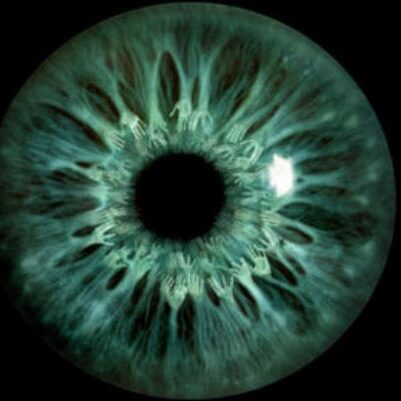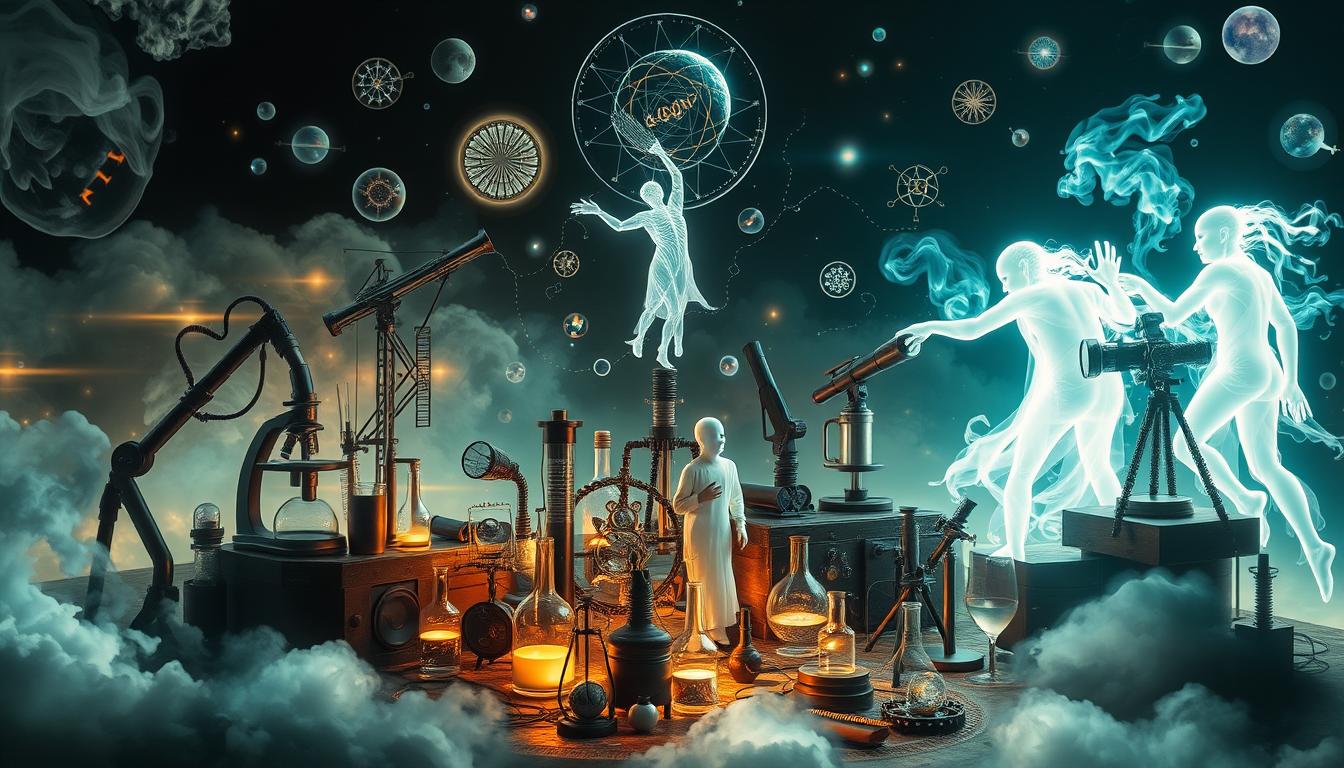A 2021 poll found that 41% of American adults believe in ghosts. Also, 20% say they’ve seen them. But scientists say we need strong evidence for such claims. There’s no proof that ghosts or other paranormal beings exist. This article will look into the science behind common ghost sightings, UFO encounters, and other supernatural events.
Key Takeaways
- Many people believe in ghosts and other paranormal things, but there’s no scientific proof.
- Our senses and how we see things can lead to mistakes, making natural events seem supernatural.
- Things like our brain’s tricks, psychology, and the environment can make us think we’ve seen ghosts.
- Science is key to figuring out why we think we see ghosts and other paranormal stuff.
- Being critical and skeptical helps us tell real from fake when it comes to strange claims.
The Enduring Belief in Ghosts and Spirits
Many people believe in ghosts and spirits, even without solid proof. A 2018 survey found 58% of people think places can be haunted. Also, about one in five in the U.S. claim to have seen a ghost. This shows that ghost stories still grab our attention.
Exploring the Prevalence of Paranormal Beliefs Across Cultures
Beliefs in ghosts vary by culture and place. Some places have more ghost stories, leading to more belief in spirits. Studies in Germany, Latin America, and Australia show similar trends.
Belief in ghosts and spirits is complex. Not everyone who believes has had a ghostly experience. Many factors, like culture and psychology, play a role in these beliefs.
| Paranormal Belief Prevalence | Percentage of Population |
|---|---|
| Believe ghosts definitely exist | 20% |
| Believe ghosts probably exist | 25% |
| Experience sleep paralysis | 8% (general population), 30% (students and psychiatric patients) |
The belief in ghosts and spirits shows our ongoing interest in the unknown. As we look at beliefs worldwide, it’s clear we’re all still drawn to the mysteries of the unseen.
The Science of Skepticism: Extraordinary Claims Require Extraordinary Evidence
The idea that “extraordinary claims require extraordinary evidence” is key in scientific skepticism. It means that claims that go against what we know, like ghosts or paranormal phenomena, need strong evidence. The scientific world sets a high standard for these claims.
Carl Sagan, an astronomer, said, “Extraordinary claims require extraordinary evidence.” This idea has helped guide how we look at extraordinary claims. But, it’s also been misused to doubt research on unusual topics.
This principle is used in many areas, from paranormal studies to mainstream science. It’s about how surprising a claim is. The more surprising, the more evidence it needs to be accepted.
“Something is extraordinary when it is unexpected,” as part of the discussion on defining extraordinary claims.
Science looks for proof through corroboration and falsification. Accepting scientific knowledge is a social process. Scientific skepticism plays a big role. It makes sure claims are thoroughly checked before they’re accepted.
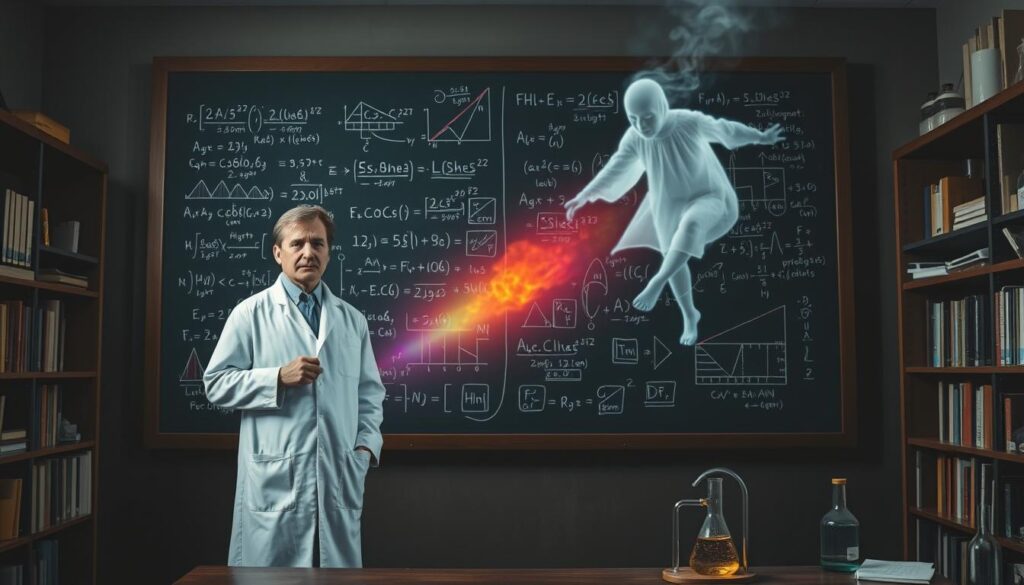
Debunking the Existence of Ghosts: Scientific Perspectives
From a scientific view, ghosts are unlikely to exist. They are seen as beings that can go through solid things, float, and change the physical world without touching it. But, all the scientific studies done for centuries have not found any proof of ghosts.
The Laws of Physics and the Implausibility of Ghosts
The laws of physics say ghosts would need a new kind of energy or matter we can’t see. This is opposite to all the evidence we have about our world. Scientists say ghosts would have to be made of something unique that goes against what we know about the universe.
- In a Chapman University survey, 58% of people in the United States agreed that places can be haunted by spirits.
- In another Pew Research Center survey, almost one in five Americans claimed to have seen or been in the presence of a ghost.
- Ghost hunters use scientific equipment on TV shows to record or measure spirit activity, but these do not provide conclusive evidence of ghosts.
- Scientists have found zero evidence supporting the existence of ghosts.
The laws of physics, as we know them, don’t allow for ghostly activities. Even though many believe in the supernatural, scientists stick to their guns. They say that debunking ghosts is key to keeping the laws of physics and proving the implausibility of ghosts.
“If ghosts were real, they would need to be made of a special type of energy that defies our current understanding of the physical world.”
Evaluating the Evidence: A Critical Look at Ghost Hunting Methods
Ghost hunting TV shows and fans claim to have found proof of ghosts, like ghostly figures and strange sounds. But scientists say the ghost hunting methods are often wrong and don’t give solid evidence. Many ghostly sights can be explained by bad lighting, broken equipment, and how our brains work.
A closer look at the evidence from ghost hunters shows problems. For example, unexplained sounds might just be normal noises. And electrical disturbances could be caused by bad wiring or other interference. Even ghostly figures can be just tricks of the light or our brains seeing shapes.
“No scientific study has been able to confirm the existence of ghosts.”
Most experts see ghost hunting as a pseudoscience. It lacks the strict science needed and relies too much on personal stories. This makes it hard to say for sure if ghosts exist.
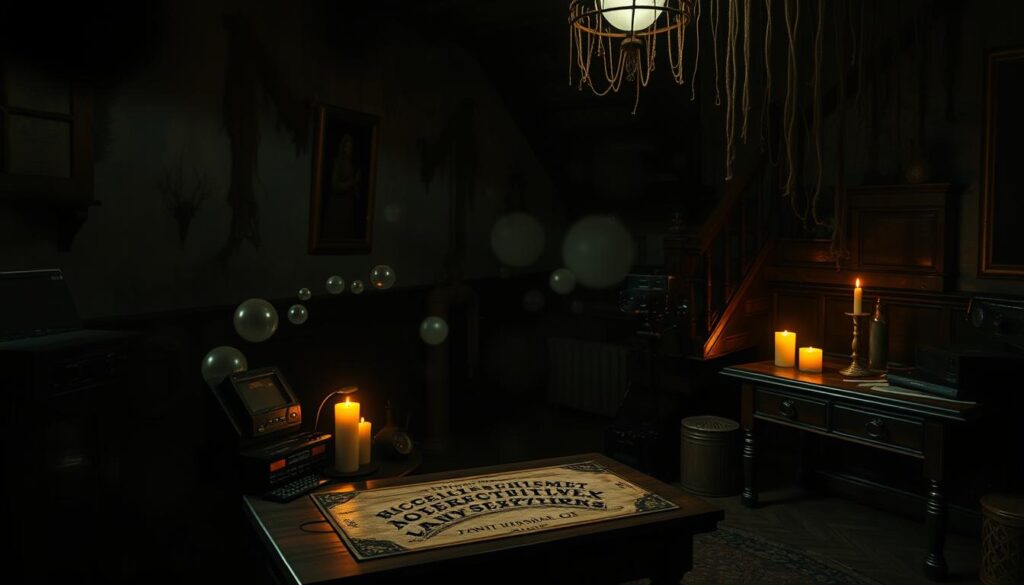
Ghost hunting might seem exciting, but we should look at it with a critical eye. Knowing the limits of these methods and how our brains can trick us helps us understand the paranormal world better. This way, we can tell what’s real and what’s not.
Scientific explanations for common paranormal experiences
Many paranormal experiences, like seeing ghosts or hearing strange noises, have scientific explanations. Things like infrasound, changes in Earth’s magnetic fields, and accidental substance ingestion can cause these feelings. People might think these are supernatural.
Infrasound under 20 hertz can make some feel fear or dread. Vic Tandy, an engineer, experienced this in a “haunted” lab. Also, research shows electromagnetic fields can create haunting feelings, as Canadian neuroscientist Michael Persinger found.
Cognitive biases and how we perceive things can also lead to seeing the paranormal. The power of suggestion can make people believe in supernatural events. Sleep paralysis and hallucinations from toxins like carbon monoxide or mold are also linked to ghost sightings.
| Paranormal Experience | Scientific Explanation |
|---|---|
| Seeing ghostly figures | Sleep paralysis, hallucinations due to environmental factors |
| Hearing strange noises | Infrasound, changes in magnetic fields |
| Feeling a presence | Electromagnetic field disturbances, cognitive biases |
Understanding the science behind paranormal experiences helps us see how complex our perception is. Our senses and biases can make us see the world in surprising ways.
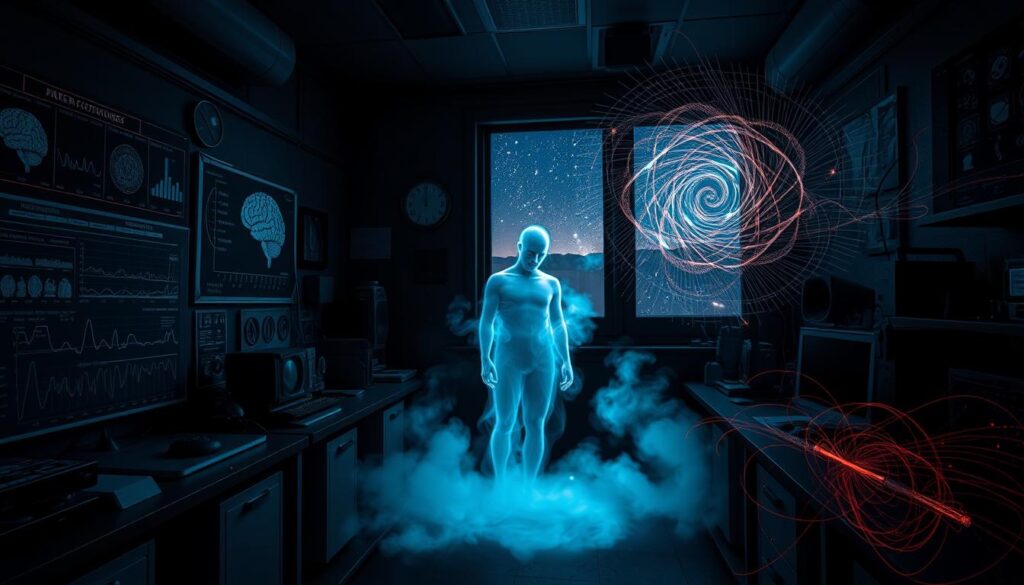
“Ghostly experiences are often the result of flaws in human perception and the brain’s tendency to find patterns in random noise.”
As we delve deeper into the science of paranormal phenomena, we get closer to understanding the world and our role in it.
The Role of Cognitive Biases and Perceptual Distortions
Your brain is not perfect and can create experiences that don’t match reality. Sleep paralysis, pareidolia, and inattentional blindness can make us think we see things that aren’t there. The neuroscience of hallucinations and perceptual distortions shows how our brain can misread what we sense and make us believe in things that aren’t real.
Studies have found that cognitive biases can make us more likely to believe in the paranormal. Biases like mentalizing, mind-body dualism, and teleological thinking can change how we see the world. They can make us think we see things that don’t exist.
| Cognitive Bias | Description | Relationship to Paranormal Beliefs |
|---|---|---|
| Mentalizing | The tendency to attribute mental states to others and to the world around us. | Mentalizing is related to belief in God, with this relationship mediated by individual differences in dualism and teleological thinking. |
| Mind-Body Dualism | The belief that the mind and body are separate entities. | Mind-body dualism influences religious and paranormal beliefs. |
| Teleological Thinking | The tendency to perceive purpose and design in natural phenomena. | Teleological thinking is associated with religious and paranormal beliefs. |
| Anthropomorphism | The tendency to attribute human characteristics and qualities to non-human entities. | Anthropomorphism is related to paranormal belief, but not religious belief. |
These biases can make us stick to our beliefs in the paranormal, even if they don’t match reality. Knowing about the neuroscience of hallucinations and perceptual distortions helps us check if paranormal claims are true. It helps us tell what’s real from what’s not.
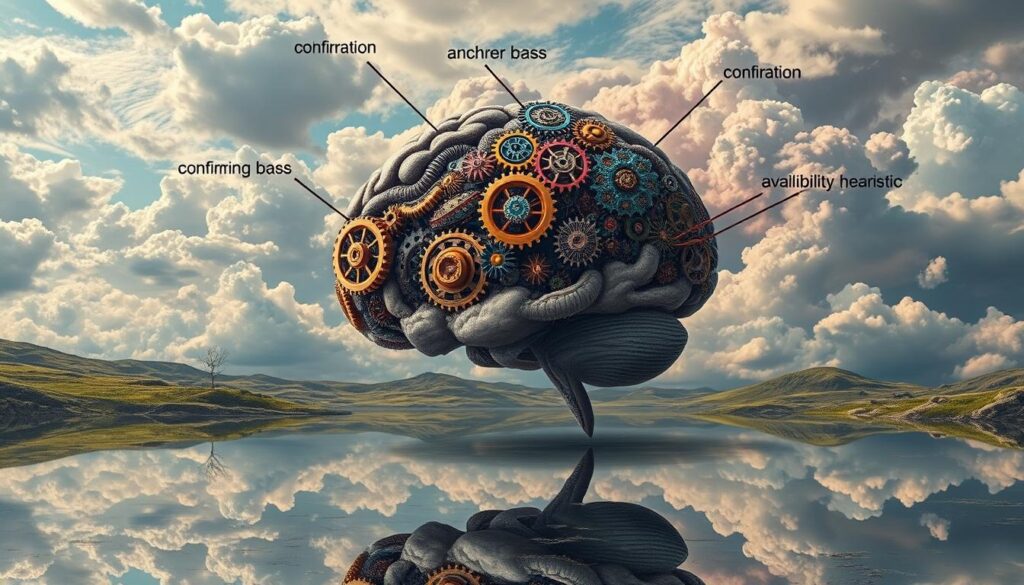
Environmental Factors: Influences on Paranormal Experiences
The environment can greatly affect your paranormal experiences. Things like infrasound, changes in the Earth’s magnetic fields, and building design can cause strange feelings. These can make you believe in ghosts or other supernatural things, even if they have natural causes.
A study with 251 people showed that those who felt the environment more reported more ghostly experiences. They found a link between high electromagnetic fields (EMFs) and these experiences. People who were more sensitive to the environment had more experiences in natural places and rooms with high EMFs.
Our surroundings can deeply affect how we see and understand strange feelings. Infrasound, which we can’t hear, can make us feel uneasy or like we’re being watched. Changes in the Earth’s magnetic field can also make us feel like we’re experiencing something supernatural.
It’s key to know that our environment can shape our beliefs and experiences, even if it’s just natural. By understanding this, we can look at paranormal experiences in a more scientific way. We can explore how our senses, perceptions, and the world around us interact.
| Key Findings | Study Details |
|---|---|
| Significantly more “haunt-type” experiences reported by environmentally sensitive individuals | Study participants: N=251 |
| Significant association between increased EMFs and reports of haunt-type experiences | Sensitives reported significantly more paranormal experiences and haunt-type experiences in a natural setting |
| Sensitives reported significantly more haunt-type experiences in ‘High EMF’ rooms compared to ‘Low EMF’ rooms | No significant difference in reported experiences between rooms among non-sensitives |
These findings show how important it is to look at environmental factors in paranormal experiences. By understanding our surroundings, we can learn more about how the physical world and our perceptions interact.
Psychological Explanations: The Power of Suggestion and Belief
Some people say they’ve had paranormal experiences that science can’t explain. But, our minds can trick us into seeing things that aren’t there. The power of suggestion and pareidolia shape how we believe and see these mysterious events.
Examining the Phenomenon of Pareidolia
Pareidolia is when our brains see patterns, like faces, in random things. This can make us think we see ghosts or paranormal stuff. Our brains want to find meaning and patterns, which can lead to seeing things that aren’t really there.
About 40% of people see phantom faces when they wake up, a phenomenon called hypnagogic hallucination. A study showed that sleep paralysis, where you wake up unable to move and see dream images, affects many. These experiences, though scary, are often just our brains making sense of unclear information.
The power of suggestion also affects our beliefs in the paranormal. If we expect to see ghosts, we might see things that aren’t there. This can make us believe in ghostly apparitions, even when there’s no real paranormal activity.
In conclusion, while the paranormal fascinates us, psychology gives us a solid explanation for these experiences. By understanding cognitive biases and the power of suggestion, we can view the paranormal with a critical and curious mind. This way, we appreciate the amazing workings of our own minds.
Pseudoscientific Claims: Separating Fact from Fiction
Many ghost hunting methods rely on pseudoscientific claims that lack solid evidence. Scientists say tools like electromagnetic field detectors and EVP recorders can’t prove supernatural presence. It’s key to know fact from when looking into paranormal claims.
Research found that 21% to 53% of students believed in paranormal or pseudoscientific ideas before a course. More females than males believed in these areas. Also, religious students and females showed more belief in these subjects.
After a critical thinking course, beliefs in these areas dropped. The biggest change was in religious students and females. This shows how important critical thinking is in science education.
| Paranormal Belief Prevalence | Percentage |
|---|---|
| About 15% of Swedish high school students showed belief in superstitions | 15% |
| 77% of Icelandic students believed in precognition | 77% |
| Half of Americans endorsed at least one conspiracy theory | 50% |
| 73% of Americans believed in at least one paranormal subject | 73% |
| 37% of Americans believed in “haunted houses” | 37% |
| 27% of UK citizens believed in communicating mentally with the dead | 27% |
| Two in five Europeans claimed to be superstitious | 40% |
Pseudoscientific claims and a lack of critical thinking spread myths about the paranormal. By focusing on real evidence, we can better understand the world and our experiences.
The Importance of Scientific Skepticism and Critical Thinking
When dealing with paranormal claims, it’s key to be scientifically skeptical and think critically. We must carefully look at the evidence, think of other reasons, and wait for solid proof. This way, we can truly understand the world and avoid fake science.
Many people believe in ghosts, with almost half of Americans saying they do. But, the methods used by ghost hunters are not real science. They mostly look for odd things and make mistakes.
Things like cold spots, strange lights, and photo anomalies can have simple explanations. It’s important to think critically and look for other reasons before believing in ghosts.
Being scientifically skeptical and critical is vital when exploring the paranormal. By using strict evidence standards, questioning our beliefs, and considering other options, we can truly understand the world. This helps us avoid fake science.
“The most powerful weapon against errors and prejudices is reason.” – Voltaire
Being skeptical and critical doesn’t mean we dismiss all paranormal claims. It means we look at them carefully, evaluate the evidence, and make decisions based on science.
By promoting scientific skepticism and critical thinking, we can better understand paranormal phenomena. This approach helps us avoid fake science and understand the world and our place in it.
Embracing Empirical Evidence: The Quest for Truth
The scientific world is on a mission to find the truth about ghosts and other mysteries. They stick to evidence and careful study. Even though ghosts haven’t been proven, scientists keep looking for answers that fit with what we know.
This search for answers is based on evidence and careful research. It’s the heart of science. By looking at facts and staying open-minded, scientists aim to uncover the truth about our world.
- The scientific community’s search for truth is driven by a dedication to empirical evidence and the systematic investigation of natural phenomena.
- While the existence of ghosts and supernatural entities remains unproven, scientists remain committed to exploring the natural world and uncovering explanations grounded in scientific principles.
- The scientific method, rooted in rigorous, evidence-based research, is the cornerstone of this quest for truth, allowing researchers to separate fact from fiction and deepen our understanding of the world around us.
“The quest for truth and knowledge is a never-ending journey, driven by curiosity, critical thinking, and a commitment to empirical evidence. As scientists, we must remain open-minded and willing to challenge our own beliefs in the pursuit of understanding the true nature of our world.”
By focusing on evidence and the scientific method, scientists keep expanding our knowledge. They light up the mysteries that have fascinated us for ages. This quest for truth is more than just learning. It’s a journey that changes how we see the world and our place in it.
Conclusion
The scientific explanations for paranormal experiences show how our senses, biases, and the world around us interact. Many believe in ghosts and supernatural things, but science offers more logical reasons. These reasons come from our brains, the environment, and how we see things.
By being skeptical and looking for evidence, you can understand these mysteries better. This way, you won’t fall for fake science claims. Seeking truth through science is the best way to learn about our world.
Research into paranormal phenomena is growing, with studies like a five-year program leading to twenty papers and a book called “Ghosted.” Personality, beliefs, culture, and past experiences affect our ghostly encounters. The Haunted People Syndrome model helps explain and deal with these experiences.
For over a century, people have reported ghostly and paranormal events. This has led researchers to study these complex, subjective experiences. They aim to understand the nature of these strange occurrences.
When exploring the paranormal, always keep an open and critical mind. Knowing about biases, distortions, and environmental factors helps you tell real from fake. Following scientific principles is the best way to uncover the truth behind these mysteries.
FAQ
What is the scientific explanation for common paranormal experiences?
Many paranormal experiences have scientific explanations. Cognitive biases, environmental factors, and human perception limits play a role. Sleep paralysis, pareidolia, and misinterpreting natural stimuli as supernatural are examples.
How prevalent are beliefs in ghosts and other paranormal phenomena?
Beliefs in ghosts and supernatural entities are common. A 2021 poll found 41% of people believe in ghosts. Belief levels vary across cultures and societies.
What is the scientific principle of “extraordinary claims require extraordinary evidence”?
This principle is key in science. It says claims that go against our current understanding need strong evidence. This includes claims about ghosts or supernatural phenomena.
Why do scientists argue that the existence of ghosts is highly implausible?
Scientists doubt ghosts because they seem to break physics rules. They can pass through walls and float without touching. Yet, physics research has found no evidence of this.
How do ghost hunting methods and paranormal investigation techniques lack scientific rigor?
Ghost hunting often uses unproven methods and tools. These include electromagnetic field detectors and EVP recorders. Scientists say these tools can’t prove supernatural presence.
What are some of the scientific explanations for common paranormal experiences?
Infrasound, Earth’s magnetic field changes, and accidental substance ingestion can cause strange feelings. Sleep paralysis and pareidolia also play a part in these experiences.
How do cognitive biases and perceptual distortions influence the perception of paranormal experiences?
The brain can misinterpret what we see and feel. This can lead to hallucinations or misperceptions. These biases and distortions can make us think we’ve had paranormal experiences.
How can environmental factors shape paranormal experiences?
The environment can greatly influence our experiences. Infrasound, magnetic field changes, and building features can cause strange feelings. These factors can make us believe in ghosts or other supernatural things.
What is the role of psychological factors in the perception of paranormal experiences?
Our minds can trick us into seeing ghosts. Expecting to see ghosts or believing in them can make us see things that aren’t there. Our brains also like to find patterns and faces, which can lead to seeing ghostly figures.
Why is maintaining a scientific skepticism and critical thinking approach important when evaluating claims about the paranormal?
Being skeptical and critical is crucial when looking at paranormal claims. We should carefully check the evidence and consider other explanations. This way, we can understand the world better and avoid false claims.
Source Links
- Are ghosts real? A social psychologist examines the evidence – https://sc.edu/uofsc/posts/2023/10/conversation-are-ghosts-real.php
- The science behind seeing ghosts – https://www.bbc.co.uk/bbcthree/article/f8ce7277-5945-470a-b1ad-0c637d8265c1
- Ghosts, Ouija boards, and ESP: Psychology and the paranormal, with Chris French, PhD – https://www.apa.org/news/podcasts/speaking-of-psychology/paranormal
- The Reality of Ghosts: A Rational Examination of the Supernatural – https://www.linkedin.com/pulse/reality-ghosts-rational-examination-supernatural-jay-alani
- Frontiers | Paranormal Belief, Thinking Style and Delusion Formation: A Latent Profile Analysis of Within-Individual Variations in Experience-Based Paranormal Facets – https://www.frontiersin.org/journals/psychology/articles/10.3389/fpsyg.2021.670959/full
- Do Extraordinary Claims Require Extraordinary Evidence? – https://www.ncbi.nlm.nih.gov/pmc/articles/PMC6099700/
- Do Extraordinary Claims Require Extraordinary Evidence?: The Proper Role of Sagan’s Dictum in Astrobiology – https://academic.oup.com/book/36896/chapter/322138781
- The science of ghosts – https://www.snexplores.org/article/science-ghosts
- Psychology: The truth about the paranormal – https://www.bbc.com/future/article/20141030-the-truth-about-the-paranormal
- Ghost hunting – https://en.wikipedia.org/wiki/Ghost_hunting
- Paranormal Investigators: Exploring a Positive Social Construct Through Paranormal Belief and Investigations – https://digitalcommons.usu.edu/cgi/viewcontent.cgi?article=2682&context=gradreports
- Things That Go Bump in the Literature: An Environmental Appraisal of “Haunted Houses” – https://www.ncbi.nlm.nih.gov/pmc/articles/PMC7304295/
- Five Scientific Explanations for Spooky Sensations – https://www.smithsonianmag.com/smart-news/five-scientific-explanations-spooky-sensations-180973436/
- The top three scientific explanations for ghost sightings – https://theconversation.com/the-top-three-scientific-explanations-for-ghost-sightings-58259
- Cognitive factors underlying paranormal beliefs and experiences – https://academic.oup.com/book/6172/chapter/149751880
- Cognitive biases explain religious belief, paranormal belief, and belief in life⠒s purpose – https://www2.psych.ubc.ca/~ara/Manuscripts/Willard_Norenzayan_Cognitive_Biases.pdf
- Microsoft Word – MassulloDisertation.doc – https://citeseerx.ist.psu.edu/document?repid=rep1&type=pdf&doi=ef7cb6c6e661b9645b08b7c9bb587f1613f746fa
- Paranormal beliefs and cognitive function: A systematic review and assessment of study quality across four decades of research – https://www.ncbi.nlm.nih.gov/pmc/articles/PMC9067702/
- Paranormal | Activity, Examples, & Facts – https://www.britannica.com/topic/paranormal
- Psychological Explanations for Seemingly Paranormal Phenomena – GoodTherapy.org Therapy Blog – https://www.goodtherapy.org/blog/psychological-explanations-for-seemingly-paranormal-phenomena-0704137/
- Reducing Pseudoscientific and Paranormal Beliefs in University Students Through a Course in Science and Critical Thinking – Science & Education – https://link.springer.com/article/10.1007/s11191-018-9956-0
- Individuals Who Believe in the Paranormal Expose Themselves to Biased Information and Develop More Causal Illusions than Nonbelievers in the Laboratory – https://www.ncbi.nlm.nih.gov/pmc/articles/PMC4503786/
- A Skeptic’s Ghost Story – https://thinkingispower.com/a-skeptics-ghost-story/
- Ghostbusters: Hunting Ghosts to Teach Scientific Skepticism – https://nobaproject.com/blog/2017-10-12-ghostbusters-hunting-ghosts-to-teach-scientific-skepticism
- Ghosts Are Not Real – NeuroLogica Blog – https://theness.com/neurologicablog/ghosts-are-not-real/
- PDF – https://www.speechanddebate.org/wp-content/uploads/23-24-Big-Questions-Topic-Resources.pdf
- PARAPSYCHOLOGY: SCIENCE OF THE ANOMALOUS OR SEARCH FOR THE SOUL? – https://www.cia.gov/readingroom/document/cia-rdp96-00789r002200120001-4
- Case Study of Recognition Patterns in Haunted People Syndrome – https://www.ncbi.nlm.nih.gov/pmc/articles/PMC9216229/
- New Psychological Research Says Paranormal Experiences Are The Norm, Not The Exception – https://www.forbes.com/sites/traversmark/2022/06/18/new-psychological-research-says-paranormal-experiences-are-the-norm-not-the-exception/
- Paranormal Experiences: Ghosts, Angels, and Other Entities – https://academic.oup.com/book/43765/chapter/371074938
